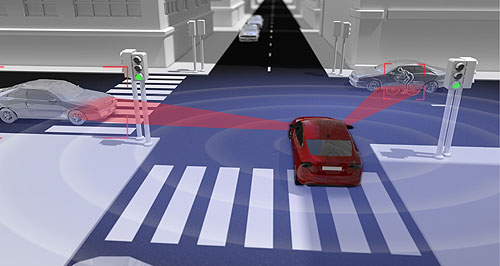Make / Model Search
News - VolvoVolvo Non-Hit project spawns life-saving techAll seeing: Volvo has combined the information received by various sensors around the car to predict collisions the driver is unable to detect. Autonomous crash mitigation tech takes Volvo closer to 2020 zero-fatality target10 Oct 2014 VOLVO has taken another step closer to realising its goal of reducing serious injuries and fatalities in its vehicles to zero, with its Non-Hit crash mitigation project almost complete. The four-year collaboration with various educational and industry institutes focused on technology that allows vehicles to locate and follow "collision-free escape routes" when faced with a potential crash situation. Where existing technology can avoid forward collisions by applying the brakes, Volvo's solution uses a wider range of information to monitor a larger area around the vehicle, and can not only slow the car but also steer it around the impending incident. The project required no new hardware, using information from existing sensors in Volvo vehicles, but the new system rapidly combines the data from the car's GPS, cameras, radar and lidar monitoring equipment to establish an escape route. If the system detects a crash is likely, it can warn the driver or a "manoeuvre generator" can assist with automatic braking and steering if no evasive action is taken. Volvo calls the information pool "sensor fusion" and says it gives the vehicle a 360-degree view to continuously monitor the changing conditions, with the technology undergoing testing on two experimental vehicles. If the technology was made available for Volvo production vehicles it would be a significant boost to the Swedish government's Vision Zero target, which aims to cut Sweden's highway fatalities and serious injuries to zero. Speaking with Australian media at the Paris motor show, Volvo Car Group research and development senior vice president Peter Mertens said that while a zero-fatality date was uncertain, the goal was attainable. “First of all it is going to happen," he said. "We say it's 2020, whether it's 2020 or 2019 or 2021 it doesn’t really matter. This is so much of a bold thing, that you can't exactly say the timing around it.”“It's us the only ones being in the automotive industry that have a bold commitment and this is what we strive for. We do the utmost in making it happen. If it is technically doable, we are going to do it.” Mr Mertens said that while the goal was ambitious, a collaboration between Volvo and the Swedish government was the best possible chance for achieving success. “We have government data which shows the fatalities in our vehicles versus fatalities in other vehicles. We are significantly better than the best competitor. Significantly. And we are very much on our way to zero fatalities already. “That is not only Sweden, it is proven with neutral data in Sweden. You don’t get that data access in other countries. But it is the same in other countries because we have neutralised that. “We are 60 per cent better than the average. Remember we have 20 per cent market share (in Sweden). So if we would take this 20 per cent market share out of the average number, it would be probably 70 per cent better than average. So I think we are well on track. “Active safety, autonomous driving that is our vehicle to get to zero fatalities.”  Read more22nd of August 2014  Volvo opens up robot car playgroundNew high-tech proving ground opened to help fine-tune safer Volvo cars24th of March 2014  Volvo tests ice-detection systemCar-to-car warning system in future Volvos alerts other cars of slippery conditions |
Click to shareVolvo articlesResearch Volvo Motor industry news |











Facebook Twitter Instagram